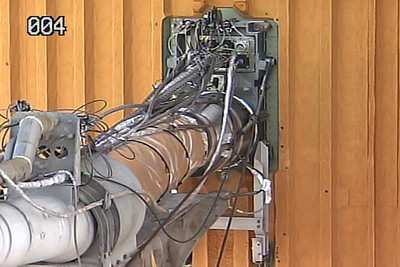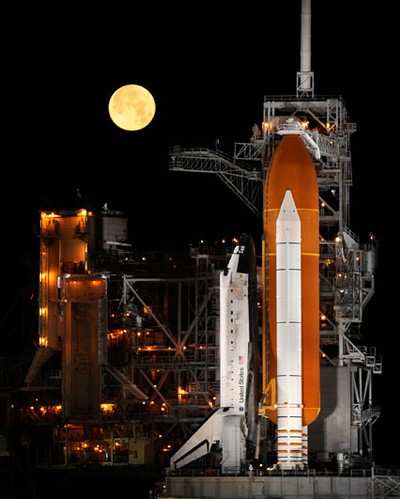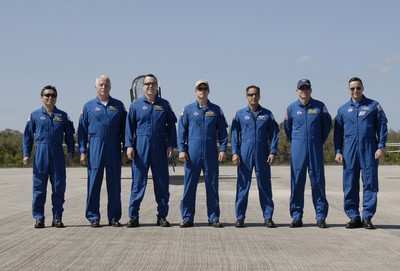Hydrogen Leak Discovered During Fueling
 ANN REALTIME UPDATE
03.12.09 0001 EDT: No sooner than Sunday. That's the
word from NASA regarding the launch of the space shuttle Discovery,
after crews discovered a potentially catastrophic hydrogen leak
while fueling the orbiter Wednesday.
ANN REALTIME UPDATE
03.12.09 0001 EDT: No sooner than Sunday. That's the
word from NASA regarding the launch of the space shuttle Discovery,
after crews discovered a potentially catastrophic hydrogen leak
while fueling the orbiter Wednesday.
Shuttle Launch Director Mike Leinbach says workers will take
their first up-close look Thursday afternoon at the gaseous
hydrogen vent line that began leaking during the countdown to
Wednesday night's scheduled launch attempt. The leak prompted a
postponement of the STS-119 launch to the International Space
Station.
If all goes well during that inspection -- and the problem is
relatively easy to fix -- NASA could make another launch attempt as
soon as Sunday.
Leinbach said the leak developed on the piping that runs from
the fixed service structure to a valve at the intertank section of
the shuttle’s external tank (shown below). The pipe moves
hydrogen gas away from the shuttle and to a flare stack near the
launch pad that burns it away safely.
There was never any danger to the shuttle while it was being
fueled... but as the leak allowed too much gaseous hydrogen to
escape the vent line, it could have been dangerous had the shuttle
launched with the leak undetected.
Leinbach told Bloomberg he's "99.9 percent sure" the leak is in
the piping from the launch gantry, and not on the shuttle tank.
Originally scheduled to liftoff February 12, Discovery was
grounded for a month as NASA examined hydrogen flow control valves
linking the external tank to the orbiter. One of those valves was
found cracked after Endeavour returned from its mission in
November; NASA opted to swap the valves originally installed on
Discovery, with lower-time parts.

It does not appear the latest issue is related to that
problem.
Earlier Reports
1455 EDT: Well, rats! NASA has once again
pushed off the launch of the space shuttle Discovery on the STS-119
mission, after a hydrogen leak was discovered in a Liquid Hydrogen
vent line between the orbiter and the external fuel tank. Engineers
found the problem during fueling operations for tonight's scheduled
launch.
NASA hopes to try again to launch Discovery at 8:54 pm EDT
Thursday evening.
The agency has not said whether the leak may be related to the
problematic hydrogen flow control valves that have delayed
Discovery's launch for nearly a month. Those valves control
hydrogen pressure inside the external tank during liftoff, and are
also located on the hardpoints between the orbiter and external
tank.
1230 EDT: It looks to be a beautiful evening
Wednesday night at Kennedy Space Center, as NASA attempts to launch
the shuttle Discovery on the latest mission to the International
Space Station.

Commander Lee Archambault will lead Discovery's crew of seven,
along with Pilot Tony Antonelli, and Mission Specialists Joseph
Acaba, John Phillips, Steve Swanson, Richard Arnold and Japan
Aerospace Exploration Agency astronaut Koichi Wakata on mission
STS-119 to the International Space Station, targeted for liftoff at
9:20 pm EDT.
The Discovery crew members are set to fly the S6 truss segment
and install the final set of power-generating solar arrays to the
International Space Station. The S6 truss will complete the
backbone of the station and provide one-fourth of the total power
needed to support a crew of six.
An updated weather forecast shows a 95 percent chance weather
will NOT be a factor for the launch, with the only possible snag
being a very slight chance of a low cloud ceiling. Weather also
looks favorable should NASA need to delay the launch by 24 hours
for technical issues; it also looks good at 48 hours out.

As ANN has reported, NASA delayed Discovery's
launch by nearly one month, as the agency investigated broken
hydrogen flow valves found after the shuttle Endeavour returned
from its STS-126 mission last November.
NASA eventually opted to replace the valves, that had been
installed between Discovery and its external fuel tank, with parts
with less time on them... resulting in the delay from the original
February 12 launch date.
 Airborne 10.15.25: Phantom 3500 Confounds, Citation CJ3 Gen2 TC, True Blue Power
Airborne 10.15.25: Phantom 3500 Confounds, Citation CJ3 Gen2 TC, True Blue Power Airborne 10.14.25: Laser Threat, VeriJet BK, Duffy Threatens Problem Controllers
Airborne 10.14.25: Laser Threat, VeriJet BK, Duffy Threatens Problem Controllers Aero-News: Quote of the Day (10.20.25)
Aero-News: Quote of the Day (10.20.25) ANN's Daily Aero-Term (10.20.25): Flameout Pattern
ANN's Daily Aero-Term (10.20.25): Flameout Pattern NTSB Final Report: Schweizer SGS 2-33A
NTSB Final Report: Schweizer SGS 2-33A






